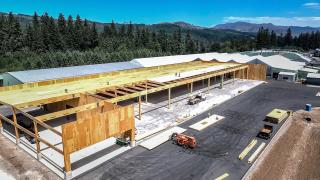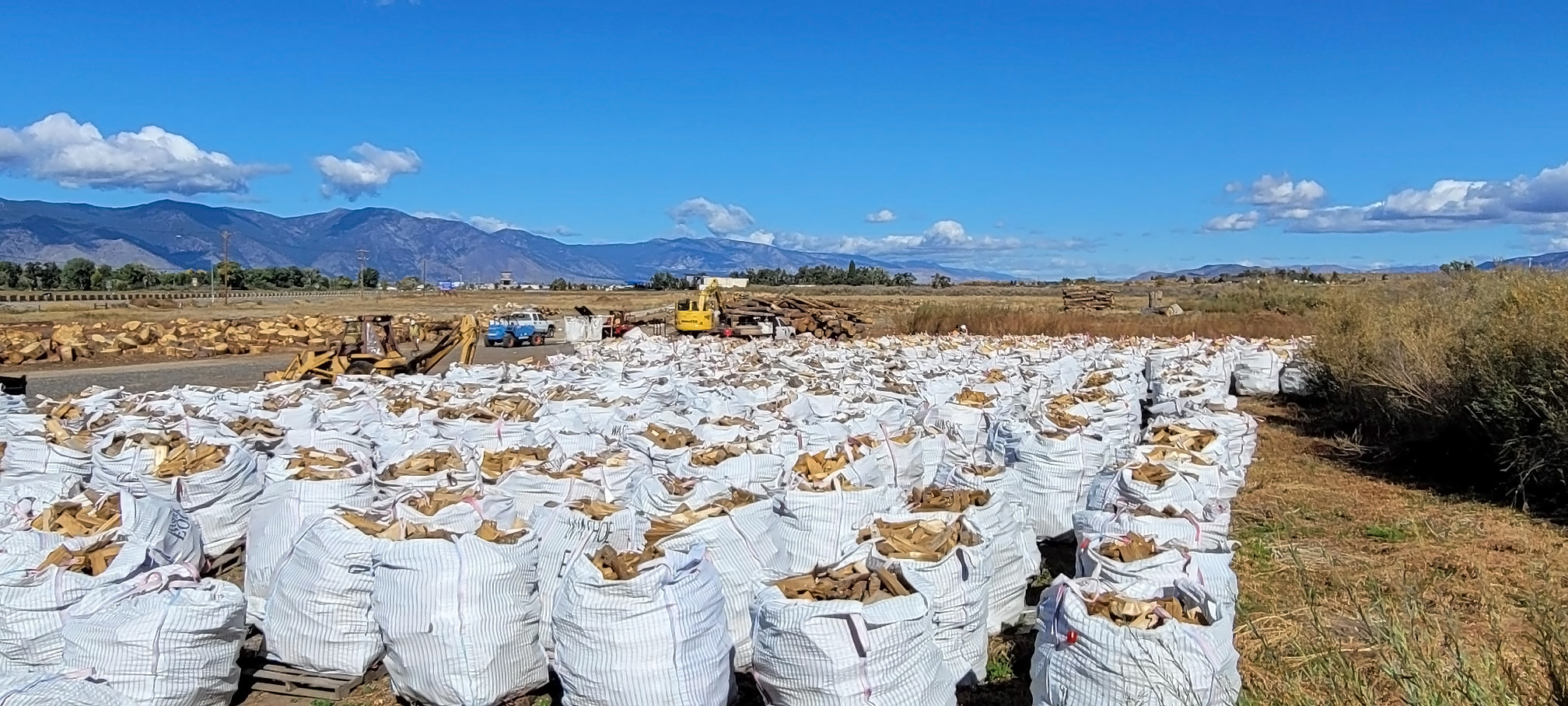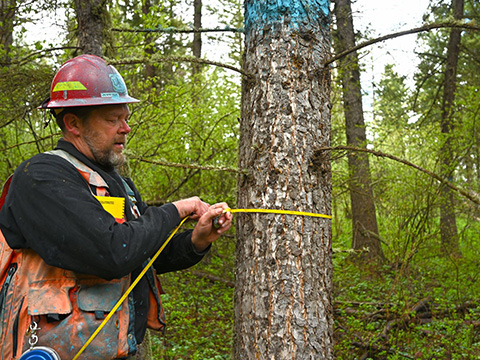Wood is a renewable resource with countless uses, and sustainably harvesting wood to make wood products is good for the health of forests and local economies. The Forest Service's Wood Innovations grants are investing in wood products economies nationwide. Freres Engineered Wood, a Wood Innovations grant recipient and a company based in Oregon's Santiam Canyon, uses sustainably sourced wood from nearby forests to make an innovative engineered wood product that can replace concrete and steel in commercial and multifamily construction projects. (USDA Forest Service video by Preston Keres)
The digital clock on the truck dash read 10:07am. The summer sun was nearing the peak of its steady ascent, but Forest Service Road #42 on the Gifford Pinchot National Forest was dark as twilight.
Peering through the towering trees, it was hard to see much beyond the edge of the gravel road, the understory thick with hanging limbs and brush. The truck wound through the darkness, when suddenly the sun seemed to burst onto the road. The trees drifted apart, wide gaps opening between trunks.
Beams of warm sunlight found their way to the forest floor and tangled vegetation gave way to wildflowers. Butterflies floated on the air. But the warm summer sun passed quickly, and in the span of just a few moments, the truck plunged back into shadow.
To the untrained eye, this break in the dense forest may seem like a random apparition of nature. To a forester, it tells a story.
“We are on a forest stewardship project on the Gifford Pinchot National Forest out of Trout Lake, which took place this last winter,” said Jesse Hohlt, Forester for Wyeast Timber Services, located in Hood River, Oregon. “I see that loggers harvested a good number of trees from this area very recently. It is a very nice thinning throughout the diameter classes. We have some younger trees, co-dominant and dominant trees above that, and overall, a very good mix of ages and species.”
How a Forest is Like a Garden

Much like a garden, forests need to be meticulously maintained. Thinning, for instance, is when trees are harvested from a dense, crowded forest. Loggers remove certain trees in places where the competition for light and nutrients is intense. Like weeding a garden, thinning leaves a population of healthy, vigorous trees that will grow healthier and stronger as a result. It also reduces the risk of a catastrophic wildfire. In turn, the trees that are harvested in thinning can be used to make valuable wood products.
At Neal Creek Forest Products in nearby Hood River, Oregon, wood that has been harvested from nearby national forests, state lands and private parcels is being made into essential products that people use every day. A spinning circular blade chews through a log, cutting out lumber. Meanwhile, on the other side of the yard, a conveyor belt drops firewood into the back of a dump truck, and a bucket loader moves bark mulch into neat piles.
Wood Innovations Grant recipient Neal Creek Forest Products works on several forest management projects on Oregon and Washington. The company is based in Hood River, Oregon, where they play an indispensable role in ensuring healthy forests. They are the boots on the ground, undertaking management activities needed to keep forests healthy, while creating local jobs and manufacturing valuable products that people use everyday. (USDA Forest Service video by Preston Keres)
“We make a range of products for local customers. Some logs will be made into basic lumber, other logs will go to our processor to make firewood that local families use to heat their home. We use the leftover material from these processes to make things like bark mulch,” described Paul Jones, CEO of Neal Creek Forest Products and Wyeast Timber Services. “We also send logs to larger sawmills nearby to make a range of more specialized lumber products, as well as to pulp mills. So, 100% of everything that we are harvesting will be used.”
Paul Jones and his companies have worked on several forest management projects in the area. They are the boots on the ground that carry out important forest management actions, while also making valuable products and putting local people to work in the woods or in manufacturing.
“We employ nearly 50 employees throughout the area, they are a very dedicated group of loggers, truck drivers, foresters, delivery drivers, producers, among others. Everyone has a common goal. They enjoy the woods, they enjoy hunting, fishing, the camaraderie, the equipment. They can also look back on their work with pride, a job well done managing the forests they love,” explained Jones.
Building Material of the Future

On the other side of the snowcapped peak of Mount Hood, middle school-aged kids shoot three pointers at the Freres Family Gymnasium at Santiam Canyon Junior/Senior High School in Mill City, Oregon. The squeak of their sneakers on the polished gym floor ricochets from stained beams overhead. These beams—in fact the whole gymnasium—is made of mass timber, a building material fabricated from wood.
Freres Engineered Wood, a local company that has been in business in this community for over 100 years, donated the mass timber for this project. Freres is using sustainably sourced wood from local forests to make this building material of the future.
“The idea behind mass timber is that you can take wood, perhaps the only true sustainable and renewable resource we have, and engineer a highly versatile and incredibly strong material that can be used as a substitute for concrete and steel in commercial and high-rise construction,” explained Kyle Freres, Vice President of Operations at Freres Engineered Wood. “And not only do you get all the ecological benefits from harvesting timber sustainably, you also get a product that has the potential to sequester carbon for hundreds of years. And you actually get many other benefits, like increasing the speed of construction. Wood really is an exciting frontier for building our urban environments.”
Freres is supplying mass timber products to an increasing number of commercial and multifamily construction projects in the region. Perhaps the most recognizable are the renovations and additions to Portland’s airport.

“Our products were used to build a nine-acre roof diaphragm for the Portland airport project. The airport essentially replaced the entire roof to the terminal core,” said Tyler Freres, Vice President of Sales at Freres Engineered Wood. “For our particular portion of the project, we produced the roof and a lot of decorative elements on the interior, such as these large sweeps that come down from the skylights, as well as some internal structures within the building. So, when people walk into the Portland airport now, they're going to be walking under just a magnificent wood structure that's sourced and produced locally.”
Tyler and Kyle Freres are especially proud of the proportion of wood material that is used to make their highest value product.
“Nearly the entire tree is used to make our engineered wooden panels: upwards of 70% of the log material goes into making these high value products,” said Kyle Freres. “Anything not used to produce panels is used to make other products, like dimensional lumber or chips. Anything we can't sell is used to generate electricity. In the end we have beneficial uses for 100% of the log.”
Not only is their operation efficient, Freres uses a cutting-edge manufacturing process that can use small diameter trees, like those that come from thinning projects, to make its engineered wood panels. The ability to source these small diameter trees supports important forest management activities on forests across Oregon. In fact, most of the logs that Freres sources for its products come from forest management projects on public lands.
Healthy Forest, Healthy Community, Healthy Economy

Back on the Gifford Pinchot, Jesse Hohlt surveys the recent thinning project.
When a thinning operation is taking place, the stark contrast between the natural setting and heavy logging equipment may seem jarring to some. Logging, no matter how selective, can seem chaotic and disruptive to nature. In a short time, however, even an untrained eye can see the many benefits of forest management.
"In three years, the average person will pass by the areas we are harvesting now and they probably won’t even know that we logged. Instead, they will see a picturesque, healthy forest,” said Hohlt.
Companies like Neal Creak Forest Products and Freres Engineered Wood play an indispensable role in managing forest lands across federal, state, private and tribal lands. They undertake the management activities needed to keep forests healthy, while creating valuable products that local people use everyday.
“Wood is the finest building material on the face of the Earth, and we've been using it for centuries. There have been buildings and structures that have stood for a thousand years built out of wood,” commented Tyler Freres. “It's something that I think is inherent to our soul, that people just know how to work with wood. In addition, it's got all these other virtues that need to be recognized. It's renewable, it's recyclable, it's free. It’s plantable, it's reusable, and it's also solar powered.”
What’s more, these companies employ local people: loggers, equipment operators, engineers, millwrights, marketing, sales, accountants and a whole host of employees are involved in making and selling wood products. They see every day there is a win-win when it comes to sustainably sourcing timber and manufacturing wood products.

“As long as we manage our forest resources for the greater good, wood is the best there is,” said Freres.
For more information on the Forest Service’s Wood Innovations Program and recipients of grants near you, visit https://www.fs.usda.gov/science-technology/energy-forest-products/wood-innovation/grants.






